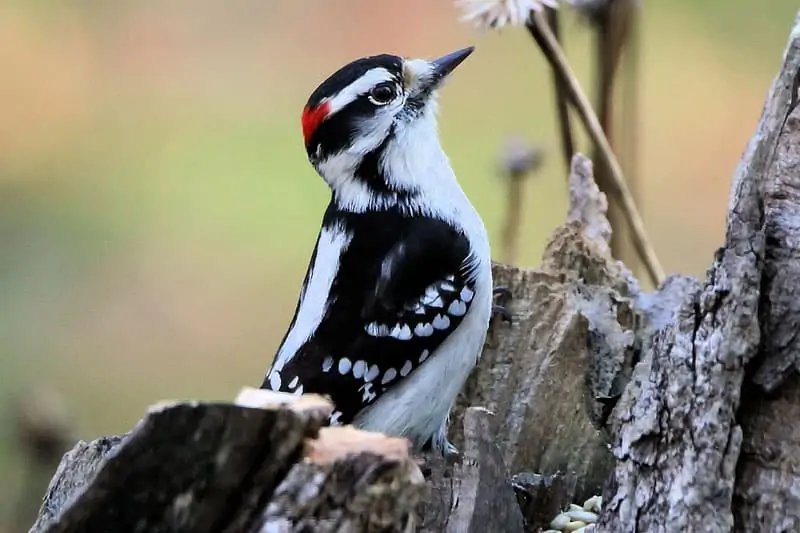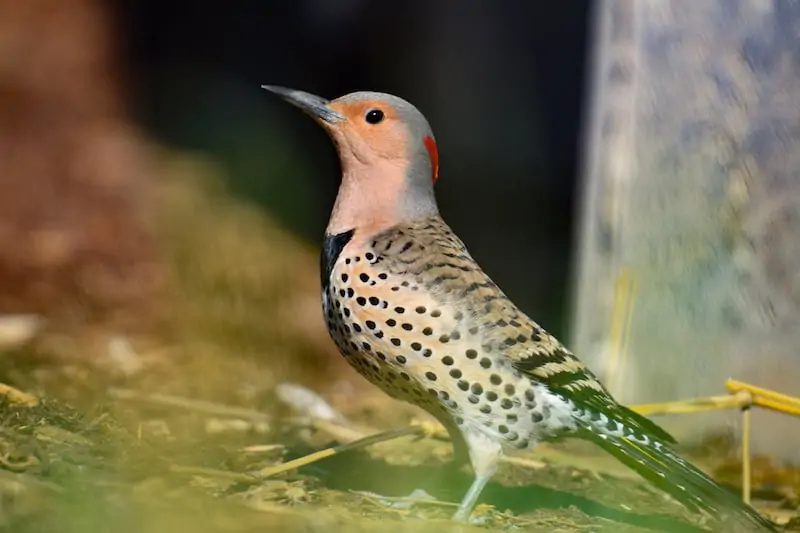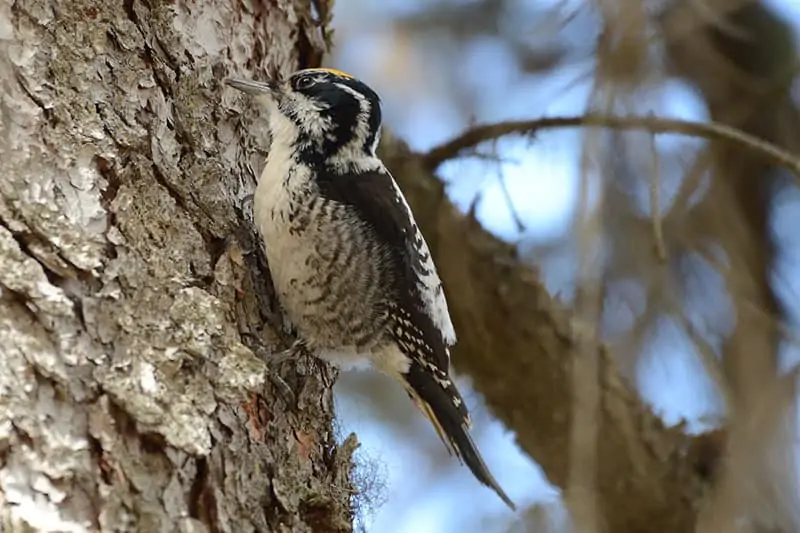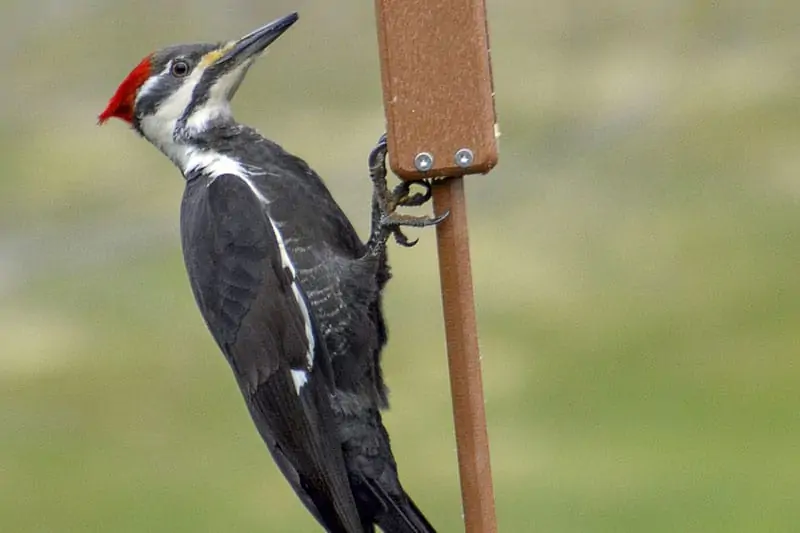There’s a good chance a woodpecker is nearby if you ever hear repeated drumming in the woods. The hammering behavior of these birds with their specialized bills has made them famous across the globe. They may be found in a variety of woodlands and forests all across America. We’ll look at the eight kinds of woodpeckers that live in Minnesota, as well as when to find them, in this article.
Lake Superior and Michigan to the east, and North and South Dakota to the west, define Minnesota’s position in the north-central United States. In addition to other geographic regions, it is the 12th biggest state in terms of total area. It contains a wide variety of mixed woods. Several woodpecker species may call Minnesota home at any time of year due to their wide range of behaviors.
9 SPECIES OF WOODPECKERS IN MINNESOTA
The American Three-toed Woodpecker, Downy Woodpecker, Hairy Woodpecker, Red-bellied Woodpecker, Red-headed Woodpecker, Black-backed Woodpecker, Yellow-bellied Sapsucker, Northern Flicker and Pileated woodpickers are the nine species of woodpickers in Minnesota.
1. DOWNY WOODPECKER

Length: 5.5-6.7 in
Weight: 0.7-1.0 oz
Wingspan: 9.8-11.8 in
In Minnesota, the Downy Woodpeckers can be found all year. They’re a little woodpecker that lives in woodlands, parks, and gardens and is most often seen in small groups. Downy Woodpeckers are one of the most likely woodpecker species to visit feeders, so providing one in your yard is a great way to attract them. They’ve been recorded drinking out of hummingbird feeders, as well as enjoying suet blocks and sunflower seeds.
On a much smaller scale, Downy Woodpeckers have the same features as other, bigger woodpeckers. While perched on the sides of trees, they have blocky heads, recognizable black and white plumage, and a straight-backed stance. Their bills, on the other hand, are shorter than those of most other species.
2. HAIRY WOODPECKER

Length: 7.1-10.2 in
Weight: 1.4-3.4 oz
Wingspan: 13.0-16.1 in
Hairy Woodpeckers have notably bigger bills than Downy Woodpeckers, which makes them look bigger. The same black and white plumage pattern is also present in them. Hairy Woodpeckers are abundant in Minnesota, however they are less common than Downy Woodpeckers. They aren’t as likely to visit parks and suburbs, but they will visit the occasional feeder if the habitat provides taller trees.
They may be located near the major limbs and trunks of big trees in woodlands and forests. They consume wood-boring insect larvae found in the beneathbark of trees, similar to other woodpeckers. Listen for their rapid, “peek” call or their vigorous hammering on wood to locate them.
3. RED-BELLIED WOODPECKER

Length: 9.4 in
Weight: 2.0-3.2 oz
Wingspan: 13.0-16.5 in
Most of Southern Minnesota is home to red-bellied woodpeckers, who can be found year-round. They have vivid red hats and bold black stripes on their backs, which are among the most vibrant in the group. They do have a crimson patch on their belly that is not normally visible. Mixed woodlands and forest, as well as the main branches of trees and near the trunks, are common habitats for them.
It is a unique characteristic of these woodpeckers. To last them through the winter, they store extra food in tree cavities and holes. This is a rarity among woodpeckers in North America, as they are one of only four species that do it. The Red-headed Woodpecker is another Minnesota species that exhibits this behavior.
4. RED-HEADED WOODPECKER

Length: 7.5-9.1 in
Weight: 2.0-3.2 oz
Wingspan: 16.5 in
The bright, red head of the red-headed woodpecker distinguishes it from other species of woodpeckers, and its bold black and white coloration on the rest of its body. In harsh sunlight, however, their red heads may be difficult to see. When tapping into trees, they create a tremendous racket that may be used to detect nearby animals. A particular, loud voice that is quickly recognizable distinguishes these woodpeckers.
These creatures have a constant decrease in population, despite the fact that they were formerly common. While you may find some throughout the breeding season in Southeastern Minnesota throughout the spring and summer, they exclusively exist in Minnesota. Look for them in dead trees and flitting from tree to tree, perch to perch.
5. BLACK-BACKED WOODPECKER

Length: 9.1 in
Weight: 2.1-3.1 oz
Wingspan: 15.8-16.5 in
Black-backed Woodpeckers are similar in size to Hairy Woodpeckers and are a medium-sized woodpecker. Their upperparts are inky black, and their underparts and face markings are white. They have strong bills that are large for their frame. A yellow crown patch is also seen in males. Between the months of May and August, Black-backed Woodpeckers may be found throughout northeastern Minnesota, however they are largely found in Canada.
Burned woodlands, which are usually between a year and eight years old, go hand in hand with these woodpeckers. Burned woods provide numerous insect species and unique foraging possibilities. When they perch, black-backed woodpeckers peel away bark to expose wood-boring beetle larvae, blending in perfectly with charred wood.
6. NORTHERN FLICKER

Length: 11.0-12.2 in
Weight: 3.9-5.6 oz
Wingspan: 16.5-20.1 in
The coloration of Northern Flickers sets them apart from other woodpeckers. Northern Flickers are mostly a dull, gray-brown color with numerous dark markings and lines on their underparts, although several woodpecker species have black and white patterned feathers. Little white patches behind their rears are visible while in the air.
They may be located year-round in woodlands and around forest boundaries in Minnesota. Northern Flickers are frequently seen sitting immediately on the ground, so be sure to keep your eyes down. Instead of boring into trees, they use their bills, which are more curved than other woodpeckers, to dig ants and bugs out of the earth.
7. PILEATED WOODPECKER

Length: 15.8-19.3 in
Weight: 8.8-12.3 oz
Wingspan: 26.0-29.5 in
In most regions of Minnesota, Pileated Woodpeckers have a few identifiable features that make them year-round woodpeckers. In terms of size, they are the biggest woodpeckers in both Minnesota and North America. These birds are nearly the size of crows.
They have a large size, with vivid white patches on their heads and chests and bright red triangular crests that make them look remarkable. They also carve distinctive, enormous oval-shaped holes in trees that serve as excellent indicators of whether or not one is present in the region.
Carpenter ants are their primary prey, which they track down in dead and rotting wood in woods, such as fallen trees. It’s possible that they’ll be attracted by leaving dead trees or stumps on your property. They may also be seen at suet feeders from time to time.
8. YELLOW-BELLIED SAPSUCKER

Length: 7.1-8.7 in
Weight: 1.5-1.9 oz
Wingspan: 13.4-15.8 in
Yellow-bellied Sapsuckers have a red head and yellow underparts, and their plumage is black and white like that of other woodpeckers. Red throat patches are also seen in males. During the breeding season in the spring and summer, these woodpeckers are only found in Minnesota, but they seem to be rather common. Young deciduous woodlands are a good place to look for them.
The different, neat rows of holes they leave behind in the bark of trees are the easiest way to tell if you’re in their territory. These sap wells are used to lap up the sap and any insects found there. While feeding, they frequently sit motionless on tree trunks.
9. AMERICAN THREE-TOED WOODPECKER

Length: 8.3-9.1 in
Weight: 1.6-2.4 oz
Wingspan: 14.6-15.3 in
Minnesota is one of the few states in the United States where the American Three-toed Woodpecker may be found, aside from a few others in the west northwest. Only found in the far northeastern sections of Minnesota, they are rather uncommon in the state. They favor ruined, aged growth woods with abundant dead or burnt trees, as well as easy access to bug eggs and larvae.
Four toes, or Zygodactyl toes, are seen in the majority of woodpeckers. Yet, these woodpeckers only feature three toes, as the name implies. Because of the leverage afforded by having just three toes, the Three-toed Woodpecker is thought to be able to lean back farther and hit its target with greater force.
In the United States, woodpeckers are not particularly prevalent. They’re more likely to be found near the water than at feeders.
HOW TO ATTRACT WOODPECKERS
Attracting woodpeckers to our feeders and yards is something we all love to do. They don’t get as much attention as chickadees, titmice, or cardinals and bring some excitement to the table. They are, however, more difficult to see and attract. Here are some ways to entice woodpeckers to visit your yard.
- Many species of woodpeckers are known for visiting bird feeders, so offer them food they like. Offer both black sunflower seed and a suet feeder. A tail prop area on a suet feeder is crucial if you want to entice bigger woodpeckers.
- Woodpeckers prefer dead and dying trees that are simple to bore holes in and provide them with plenty of insect larvae. Leave dead trees alone.
- Many woodpecker species will utilize nest boxes that have been erected. From May to July, pileated woodpeckers use nesting boxes.
- Woodpeckers may occasionally enjoy fruits and berries like dogwood, serviceberry, tupelo, mountain ash, strawberry, cherry, grapes, bayberry, holly, blueberries; mulberry; brambles.
- Woodpeckers will utilize bird baths in the same manner as any other birds, so it’s important to ensure you have a water source, such as a water mover or solar fountain. In order for the fountain not to stop every time the sun goes behind a cloud, solar fountains with batteries are best.
